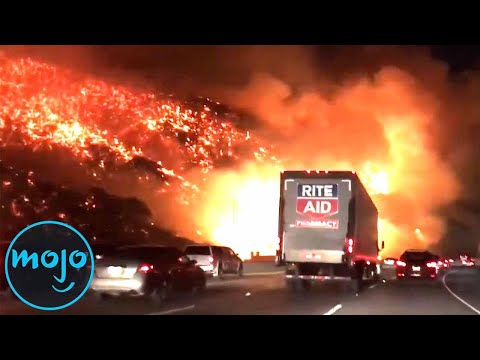What is the most catastrophic event in history
When it comes to natural disasters, there have been several catastrophic events throughout history. However, one of the most devastating events in recorded history is the 2004 Indian Ocean earthquake and tsunami. This megathrust earthquake, also known as the Sumatra-Andaman earthquake, occurred on December 26, 2004, off the west coast of northern Sumatra, Indonesia.
The earthquake had a magnitude of 9.1–9.3, making it one of the strongest ever recorded. The resulting tsunami, triggered by the underwater earthquake, caused massive destruction across several countries, including Indonesia, Thailand, Sri Lanka, India, and the Maldives. It is estimated that the tsunami claimed the lives of approximately 230,000 people and caused billions of dollars in damages.
What are the catastrophic events
Natural disasters come in various forms and can have catastrophic consequences. Some of the most common catastrophic events include earthquakes, hurricanes, tornadoes, floods, volcanic eruptions, and wildfires.
Each of these events has the potential to cause extensive damage to property, infrastructure, and loss of life. The severity of the impact depends on factors such as the magnitude of the event, the population density in the affected area, and the preparedness and response of the affected communities.
What is the most catastrophic type of natural disaster
It is challenging to determine the most catastrophic type of natural disaster, as the severity of each event can vary depending on the circumstances. However, one type of natural disaster that often leads to significant destruction is a hurricane.
Hurricanes, also known as tropical cyclones or typhoons, are massive storms that form over warm ocean waters and can cause strong winds, heavy rainfall, storm surges, and flooding. These storms can span hundreds of miles and can last for days, leaving a trail of devastation in their wake.
Some of the most destructive hurricanes in history include Hurricane Katrina, which struck the Gulf Coast of the United States in 2005, causing widespread flooding and destruction, and Hurricane Haiyan, which devastated the Philippines in 2013, claiming thousands of lives and causing extensive damage.
Understanding Earthquakes: The Shaking Ground
Earthquakes are one of the most powerful and unpredictable natural disasters on Earth. They occur when there is a sudden release of energy in the Earth’s crust, resulting in seismic waves that shake the ground. These waves can cause buildings to collapse, landslides, and tsunamis in coastal areas.
Earthquakes can occur anywhere in the world, but they are most commonly found along tectonic plate boundaries. The movement and interaction of these plates create stress and strain on the Earth’s crust, which is released in the form of earthquakes.
While scientists have made significant progress in understanding earthquakes, accurately predicting when and where they will occur remains a challenge. However, advancements in technology and monitoring systems have helped to improve early warning systems and provide valuable information to communities at risk.
Unleashing the Fury: The Power of Hurricanes
Hurricanes are tropical cyclones that form over warm ocean waters and are characterized by strong winds and torrential rainfall. These powerful storms can cause significant damage to coastal regions, including flooding, storm surges, and high winds.
One of the most devastating hurricanes in recent history is Hurricane Katrina, which struck the Gulf Coast of the United States in 2005. The storm caused massive flooding in New Orleans and other parts of Louisiana, resulting in the loss of more than 1,200 lives and causing billions of dollars in damages.
To better understand the power of hurricanes, it is essential to know how they form. Hurricanes require warm ocean waters, moist air, and favorable atmospheric conditions to develop. As the warm air rises and cools, it forms clouds and releases energy, fueling the storm’s growth and intensification.
While meteorologists have made significant progress in tracking and predicting hurricanes, these storms can still be unpredictable and pose a significant threat to coastal communities. It is crucial for residents in hurricane-prone areas to have emergency plans in place and stay informed about the latest weather updates and evacuation orders.
The Fiery Inferno: Exploring Volcanic Eruptions
Volcanic eruptions are one of the most spectacular and destructive natural events on Earth. They occur when molten rock, ash, and gases are expelled from a volcano, often with explosive force. These eruptions can cause widespread destruction, including the destruction of entire communities and the alteration of landscapes.
One of the most famous volcanic eruptions in history is the eruption of Mount Vesuvius in 79 AD, which buried the cities of Pompeii and Herculaneum under layers of ash and pumice. This catastrophic event preserved the cities in remarkable detail, providing valuable insights into the daily life of the ancient Roman civilization.
Volcanic eruptions are typically preceded by increased seismic activity and other warning signs, allowing scientists to monitor and study these events. However, predicting the exact timing and magnitude of an eruption remains a challenge. Volcanic monitoring systems and early warning systems have been implemented in many volcanic regions to help mitigate the risks associated with these natural disasters.
When the Sky Turns Dark: Tornadoes and their Devastating Power
Tornadoes are powerful and destructive storms characterized by a rotating column of air that extends from a thunderstorm to the ground. These violent storms can cause significant damage, including the destruction of buildings, uprooting of trees, and the loss of life.
The United States experiences more tornadoes than any other country, with an average of over 1,000 tornadoes reported each year. The central region of the country, known as Tornado Alley, is particularly prone to tornado activity due to the clash of warm, moist air from the Gulf of Mexico and cool, dry air from Canada.
While tornadoes can occur at any time of the year, they are most common during the spring and summer months. Meteorologists use advanced radar systems and storm chasers to track and predict tornado activity, providing valuable warnings to communities in the path of these destructive storms.
Frequently Asked Questions
Can natural disasters be prevented?
While it is not possible to prevent natural disasters from occurring, measures can be taken to mitigate their impact. This includes implementing early warning systems, improving infrastructure resilience, and educating communities about disaster preparedness and response.
How are natural disasters classified?
Natural disasters are classified based on their cause. For example, earthquakes, hurricanes, tornadoes, floods, volcanic eruptions, and wildfires are all different types of natural disasters.
Are natural disasters becoming more frequent?
There is evidence to suggest that certain types of natural disasters, such as hurricanes

